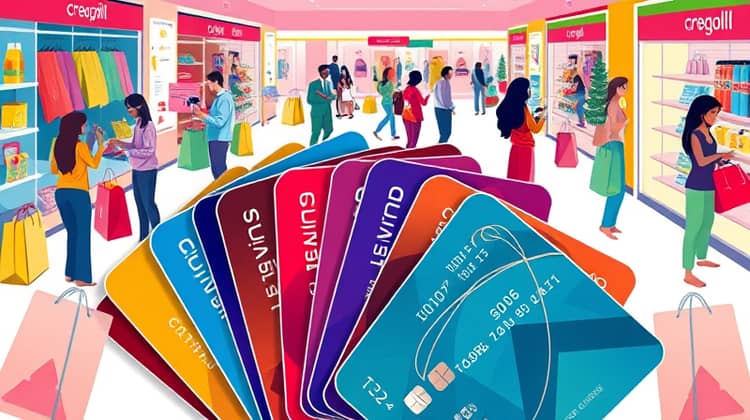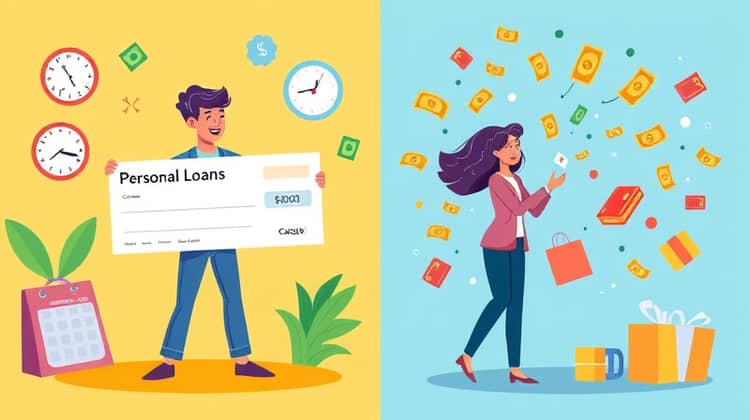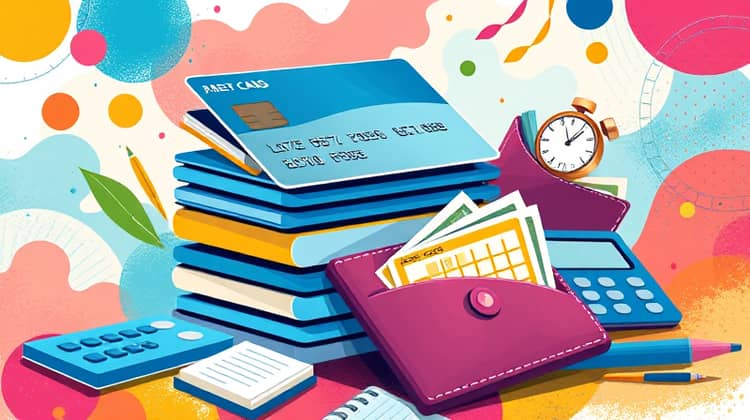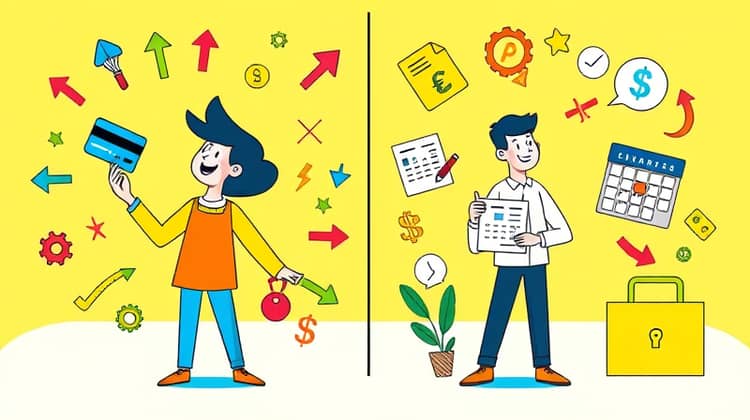Navigating the world of personal finance involves understanding the various borrowing options available, including personal loans and credit cards. Each option has its own set of benefits and drawbacks, making it crucial for consumers to weigh the alternatives carefully before making a choice. This article will explore the ins and outs of personal loans and credit cards, offering insights into their features, costs, and ideal usage scenarios. By the end, readers should have a clearer understanding of which option may best suit their financial needs.
Understanding Personal Loans

Personal loans are fixed amounts of money borrowed from a financial institution that are paid back over a predetermined period, typically with a fixed interest rate. Borrowers can use these loans for various purposes, such as consolidating debt, financing a large purchase, or covering unexpected expenses. Personal loans usually require a credit check and may have specific income or employment requirements to qualify, making it essential for borrowers to understand their financial situation before applying.
These loans generally offer higher loan amounts and longer repayment terms compared to credit cards, making them more suitable for significant expenses. However, the application process may take longer, and there may be penalties for early repayment or late payments, so it’s important for consumers to read the terms carefully.
- Typically involve fixed interest rates and set repayment terms
- Larger borrowing amounts compared to credit cards
- Can be used for various purposes, including debt consolidation
- Application process may take longer than credit cards
- May require a credit check and proof of income
- Can enhance credit score if paid on time
Understanding Credit Cards

Credit cards are revolving lines of credit that allow users to borrow against a specified credit limit. They come with the flexibility to make purchases and pay off the balance over time, with interest accruing on any unpaid balance. Credit cards are widely recognized for their convenience, enabling users to shop online and in-store, make travel reservations, and even earn rewards through spending, which can enhance their overall value.
However, managing credit card debt can be challenging, especially if one carries a balance month-to-month. Interest rates on credit cards can be substantially higher than those of personal loans, and if not managed effectively, users can quickly find themselves in a cycle of debt. Understanding the credit card terms, such as minimum payments and interest rates, is crucial for maintaining financial health.
- Revolving credit with a specified credit limit
- Flexible repayment options, with a minimum monthly payment
- Can accrue rewards or cash back on spending
- Application process is usually quick and easy
- High-interest rates on unpaid balances
- Potential for accruing debt if not managed well
Key Differences: Personal Loans vs. Credit Cards

While both personal loans and credit cards provide access to funds for borrowers, they serve different purposes and come with distinct characteristics that cater to varying financial needs. Understanding these key differences can help individuals make informed decisions.
- Personal loans have fixed repayment terms, while credit cards offer revolving credit.
- Interest rates on personal loans are often lower than those on credit cards.
- Personal loans usually involve a larger sum of money compared to credit cards, which are more suitable for everyday expenses.
- Obtaining a personal loan may entail a more rigorous application process than acquiring a credit card.
How to Decide: Personal Loans or Credit Cards?

Choosing between a personal loan and a credit card largely depends on the individual's financial needs and circumstances. Analyzing the purpose of the funds, repayment structure, and overall financial habits can provide valuable insights into what option is more beneficial.
- Assess the purpose for needing the funds: is it a large, one-time expense or ongoing purchases?
- Consider the total cost of borrowing, including interest rates and fees.
- Evaluate your financial discipline: are you able to manage debt responsibly?
1. Purpose

The very first step in determining which option is right for you is to clearly define the purpose behind borrowing. Personal loans are generally favored for larger expenses that require a lump sum, such as home renovations, medical bills, or even consolidating existing debts into one payment. They can also provide a more structured approach to repayment, making them easier to manage in a long-term financial plan.
Credit cards, on the other hand, are ideal for smaller, everyday expenses or emergencies when immediate access to funds is needed. They offer flexibility in spending, allowing consumers to make purchases and pay back the amount at their convenience, as long as they stay within their credit limit.
2. Interest Rates

Interest rates play a crucial role in the comparison of personal loans and credit cards. Personal loans typically come with lower annual percentage rates (APRs) compared to credit cards, particularly if the borrower has good credit. This makes personal loans a more cost-effective option for those looking to borrow a substantial amount of money.
Credit cards usually have higher interest rates, and if the balance is not paid in full promptly, this can lead to accumulating debt quickly. As a result, borrowers must consider their repayment habits and financial discipline when choosing between these two borrowing options.
Understanding the nuances of interest rates in both personal loans and credit cards can have a significant impact on the total cost of borrowing over time. It’s essential to shop around for the best interest rates to ensure financial prudence.
3. Repayment Terms

Another important consideration is the repayment terms associated with each borrowing option. Personal loans typically offer a fixed repayment schedule, allowing borrowers to make consistent monthly payments over a defined period, which can range from a few years to several years depending on the loan amount and lender policies.
In contrast, credit cards require only minimum payments each month but allow users to carry a balance month-to-month. While this may seem more flexible, it can lead to substantial debt if the balance continues to grow due to accrued interest. Borrowers should carefully evaluate their repayment preferences and abilities when choosing between the two options.
- Personal loans have fixed repayment terms and predictable monthly payments.
- Credit cards require only minimum payments, which can lead to prolonged debt if balances are rolled over.
- Personal loans typically span a few years, while credit cards can have open-ended terms.
4. Credit Score Impact

The choice between personal loans and credit cards can also affect one's credit score in different ways. Personal loans, when repaid on time, can positively contribute to enhancing credit scores and may help diversify credit types in a credit report, which can boost future loan applications.
Credit cards can also impact credit scores, particularly through credit utilization rates — the ratio of current credit card balances to total available credit. Keeping this utilization rate low is essential for maintaining a healthy credit score. However, missing payments can significantly harm credit standings.
- Personal loans can improve credit scores by adding installment debt to a credit report.
- Credit utilization ratio is important for credit cards; high utilization can harm scores.
- Timely repayments on both options contribute positively to credit histories.
5. Fees and Penalties

When considering personal loans and credit cards, it's imperative to take into account any associated fees and potential penalties. Personal loans typically come with origination fees, late payment fees, and prepayment penalties. Understanding these costs can help borrowers calculate the actual cost of borrowing effectively.
Credit cards may also have various fees such as annual fees, late payment charges, and cash advance fees. Knowing these fees upfront can prevent unpleasant surprises down the line.
- Personal loans may have origination and prepayment fees.
- Credit cards can carry annual fees and late payment charges.
- Understanding all fees helps manage overall borrowing costs.
Ultimately, being aware of potential fees and ensuring that you can afford them is critical to managing your financial health when borrowing.
6. Flexibility

Flexibility is another significant factor to consider when weighing personal loans against credit cards. Credit cards often offer greater flexibility, allowing users to borrow as needed within their credit limits and to repay amounts at their convenience, albeit with caution to avoid debts spiraling out of control.
Conversely, personal loans provide less flexibility, as borrowers receive a lump sum and must adhere to fixed repayment terms and schedules. This rigidity can be beneficial for those who need structure in their budgeting but may not be ideal for those who prefer adaptable repayment plans.
Conclusion

In conclusion, the choice between personal loans and credit cards hinges on individual financial circumstances, borrowing needs, and personal budgeting styles. While both options provide beneficial features, they are specially suited for different purposes and should be approached with careful consideration. Understanding the nuances of both can empower consumers to make informed decisions that align with their financial goals.
Ultimately, it is advisable for consumers to evaluate their unique situation, comprehension of costs, repayment abilities, and overall financial plans in order to select the most appropriate borrowing option for their needs.














